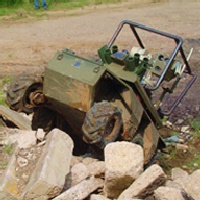The Gladiator TUGV will provide the Marine Corps Ground Combat Element (GCE) with an unmanned tele-operated/semi-autonomous ground vehicle for remoting combat tasks in order to reduce risk to the warfighter. Gladiator will increase USMC capability by increasing survivability of individual Marines, enhancing the ability of tactical commanders to rapidly detect, identify, locate, and neutralize a variety of threats, and providing real-time and longer range combat information to tactical commanders. The Gladiator system includes a mobile base unit (MBU), mission payload modules (MPM), an operator control unit (OCU), and a data link (DL).
In 2002-2004 the OSD Joint Robotics Program and the Office of Naval Research (ONR) funded an RDT&E program to develop technologies that dramatically increased the performance, capabilities, and affordability of the Gladiator. A team led by Carnegie Mellon University, developed a prototype Gladiator system that was successfully demonstrated in February and July 2004. The focus of those demonstrations was on robotic mobility and robotic scouting, respectively.
Following successful conclusion of the ONR program, the Robotics Systems Joint Project Office (RS JPO) in Huntsville Alabama conducted a competitive procurement for the System Development and Demonstration (SDD) program. The program includes finalizing the Gladiator design, building six prototype vehicles and delivering these vehicles with an appropriate support package to the Marines for operational evaluation in 2006. On February 7, 2005, RS JPO awarded a $26.4M SDD contract to Carnegie Mellon University.
In partnership with its primary subcontractor, BAE Systems, the Carnegie Mellon team is in the process of designing and developing a Gladiator system that will adhere to Marines Corps’ requirements.
current head
current contact
past staff
- John Bares
- Julie M Derence

